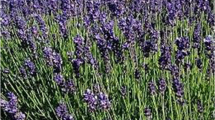Abstract
An antifungal protein with a molecular mass of 14.3 kDa was isolated from the seeds of butterfly pea (Clitoria ternatea) and designated as Ct protein. The antifungal protein was purified using different methods including ammonium sulphate precipitation, ion exchange chromatography on DEAE-cellulose and gel filtration on Sephadex G-50 column. Ct protein formed a single colourless rod-shaped crystal by hanging drop method after 7 days of sample loading. The protein showed lytic activity against Micrococcus luteus and broad-spectrum, fungicidal activity, particularly against the most clinically relevant yeasts, such as Cryptococcus neoformans, Cryptococcus albidus, Cryptococcus laurentii, Candida albicans and Candida parapsilosis. It also exerted an inhibitory activity on mycelial growth in several mould species including Curvularia sp., Alternaria sp., Cladosporium sp., Aspergillus flavus, Aspergillus fumigatus, Aspergillus niger, Rhizopus sp., and Sclerotium sp. The present study adds to the literature on novel seed proteins with antifungal activity.








Similar content being viewed by others
References
Kondori, N., Baltzer, L., Dolphin, G. T., & Mattsby-Baltzer, I. (2010). International Journal of Antimicrobial Agents, 37, 51–57.
Ng, T. B. (2004). Peptides, 25, 1215–1222.
Ho, V. S., Wong, J. H., & Ng, T. B. (2007). Peptides, 28, 760–766.
Wong, J. H., Ng, T. B., Cheung, R. C., Wang, H. X., Lam, S. K., Lin, P., et al. (2010). Applied Microbiology and Biotechnology, 87, 1221–1235.
Selitrennikoff, C. P. (2001). Applied and Environmental Microbiology, 67, 2883–2894.
Ellis, M. (2002). Molecular Immunology, 38, 947–957.
Ajesh, K., & Sreejith, K. (2012). Mycopathologia, 174, 409–419.
Hossain, M. A., & Ghannoum, M. A. (2000). Expert Opinion on Investigational Drugs, 9, 1797–1813.
Wong, J. H., Ng, T. B., Jiang, Y., Liu, F., Sze, S. C., & Zhang, K. Y. (2010). Protein and Peptide Letters, 17, 1040–1047.
Ginsburg, H., & Deharo, E. (2011). Malaria Journal, 15(Suppl 1), S1.
Huynh, Q. K., Borgmeyer, J. R., & Zobel, J. F. (1992). Biochemical and Biophysical Research Communications, 182, 1–5.
Sawano, Y., Miyakawa, T., Yamazaki, H., Tanokura, M., & Hatano, K. (2007). Biological Chemistry, 388, 273–280.
Gomez, S. M., & Kalamani, A. (2003). Pakistan Journal Nutrition, 2, 374–379.
Diz, M. S., Carvalho, A. O., Rodrigues, R., Neves-Ferreira, A. G., Da Cunha, M., Alves, E. W., et al. (2006). Biochimica et Biophysica Acta, 1760, 1323–1332.
Ribeiro, S. F., Carvalho, A. O., Da Cunha, M., Rodrigues, R., Cruz, L. P., Melo, V. M., et al. (2007). Toxicon, 50, 600–611.
Schagger, H. (2006). Nature Protocols, 1, 16–22.
Aliahmadi, A., Roghanian, R., Emtiazi, G., & Ghassempour, A. (2011). Iranian Journal of Microbiology, 3, 104–108.
Bradford, M. M. (1976). Analytical Biochemistry, 72, 248–254.
Clinical and Laboratory Standards Institute. (2002). Reference method for broth dilution antifungal susceptibility testing of yeasts (Approved standard M27–A2. 2nd edn). USA: Wayne.
Wang, H., & Ng, T. B. (2001). Biochemical and Biophysical Research Communications, 288, 765–770.
Gaur, V., Qureshi, I. A., Singh, A., Chanana, V., & Salunke, D. M. (2010). Plant Physiology, 152, 1842–1850.
Ngai, P. H., Zhao, Z., & Ng, T. B. (2005). Peptides, 26, 191–196.
Ng, T. B., & Wang, H. X. (2000). Life Sciences, 68, 739–749.
Wang, H., & Ng, T. B. (2001). Biological Chemistry, 382, 947–951.
Wang, H. X., & Ng, T. B. (2003). Peptides, 24, 969–972.
Wang, S., Ng, T. B., Chen, T., Lin, D., Wu, J., Rao, P., et al. (2005). Biochemical and Biophysical Research Communications, 327, 820–827.
Sawasdipuksa, N., Lei, Z., Sumner, L. W., Niyomploy, P., & Sangvanich, P. (2011). Food Technology and Biotechnology, 49, 489–494.
Wang, H., & Ng, T. B. (2001). Biochemical and Biophysical Research Communications, 289, 120–124.
Conflicts of Interest
The authors confirm that this article content has no conflicts of interest.
Author information
Authors and Affiliations
Corresponding author
Rights and permissions
About this article
Cite this article
K, A., K, S. A Novel Antifungal Protein with Lysozyme-Like Activity from Seeds of Clitoria ternatea . Appl Biochem Biotechnol 173, 682–693 (2014). https://doi.org/10.1007/s12010-014-0880-8
Received:
Accepted:
Published:
Issue Date:
DOI: https://doi.org/10.1007/s12010-014-0880-8




